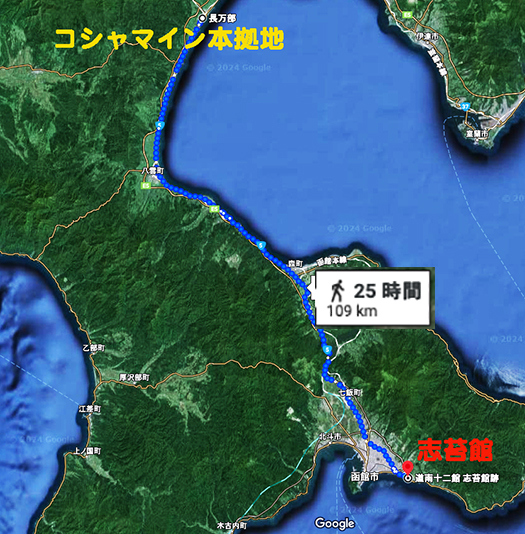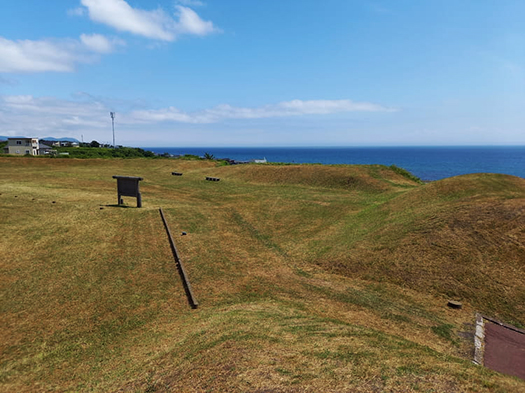

北海道島の歴史でアイヌ民族と道南十二館という鎌倉〜江戸期の日本社会由来の「武家勢力」の確執、騒乱は繰り返し勃発する。はるかな後世人である北海道人にとっては、避けては通れない歴史の局面だけれど、明治以降の近現代が深く直接的で歴史認識の大部分を占めているので、どうしても縁遠さを感じる。日本史でも北海道は本格的には明治以降の開拓史が中心。
松前藩というのは北海道島の最南西端の海岸線にしがみついている、という認識。しかし今回探訪してみると、やはり先人達のこの地での息づかいは強く伝わってくる。
この「コシャマインの戦い」が本格的なアイヌの人びとと和人社会の戦端の嚆矢だけれど、勃発した1457年という時代相が、日本全体にとってどういった背景になっていたのか、連関を確認してみる。
●1455年
享徳の乱 第5代「鎌倉公方」足利成氏が関東管領・上杉憲忠を暗殺したことから開始。現代の歴史研究において享徳の乱は、関東地方における戦国時代の始まりと位置付けられている。室町「幕府将軍家」と結んだ山内上杉家、扇谷上杉家が鎌倉公方の足利成氏と争い関東地方一円に戦乱拡大。
●1457年
太田道灌江戸城築城。
「コシャマインの乱」蝦夷南部で勃発し後の松前家始祖・武田信広がこれを鎮圧。
●1467年
応仁の乱 8代将軍足利義政の継嗣争いなどで発生した内乱。全国「戦国時代」突入。
このように地理関係と歴史事実の時間関係を関連させると、大きな背景がみえてくる。この志苔館・小林氏は前にみたように1300年代後期に北海道島に流れてきている。群馬県・上野国の地場勢力が南北朝騒乱期に南朝方として活動した後、新天地北海道島に活路を求めた武士団。
戦国は各地域の一所懸命が進んで経済力が上がって、その経済力を武力で争奪する時代であり、その経済力が北海道島ではアイヌ社会との「交易」による利得だった。コンブは京都などでも日本の味覚文化の基礎を形成し遠く沖縄島までも「コンブ文化圏」に大きく包含されていった。さらに鮭食文化も本州地域に広がっていって、北海道島の「原料出荷地域」としての価値が飛躍的に高まっていった。
こういう背景事情の中で、アイヌ社会自身も大きく日本社会の貨幣経済に影響され、現地では道南十二館勢力の「搾取」を日常的に受けるようになっていたのだろう。志苔館周辺のアイヌ少年の殺害は、当時のアイヌの人びとの戦闘力の強化、軍事的対抗という方向に向かわせた。
総数1万というアイヌの軍団が長万部の族長コシャマインに率いられて、焦点の志苔館(防衛軍300人)に襲いかかり、一気に落城させる。武家はアイヌ社会の軍事力を侮っていたか。
北海道島でも「戦国乱世」が出来したというように言えるのだろうか。
しかしこういう対決状況について、それをどう処理するか、あるいはそういう軋轢を極力避けるような努力は、和人勢力側になかったのか。交易を経済基盤とするかれら和人武家と、本州以南の農地を基盤とする武家勢力との、体質の違いのようなものを感じさせられる。・・・<つづく>
English version⬇
Japan’s “Warring States” and Hokkaido Island: The Battle of Koshamain-2
Ten years before the Onin War. The Kanto region had already entered the Warring States period, and on the island of Hokkaido, Japanese warriors and the Ainu community were engaged in an armed struggle. The Warring States of the North. …
In the history of the island of Hokkaido, feuds and uprisings between the Ainu people and the Donan Junkan, a group of warrior clans that originated in Japanese society from the Kamakura period to the Edo period, have broken out repeatedly. For those of us in Hokkaido, who live far back in history, this is an unavoidable aspect of our history, but since modern history since the Meiji period has been deeply and directly related to our understanding of history, we cannot help but feel a sense of estrangement from the island. Even in Japanese history, Hokkaido’s history has been dominated by the history of development since the Meiji period.
The Matsumae Clan was thought to be clinging to the southwesternmost coastline of the island of Hokkaido. However, when I visited the area this time, I could still strongly feel the breath of our predecessors in this region.
The Battle of Koshamain was the first full-scale war between the Ainu people and Japanese society, but let us examine the background of the war in 1457.
The Kyoutoku Rebellion of 1455 began with the assassination of Kanto governor Uesugi Kentsada by Ashikaga Naruke, the fifth “Lord of Kamakura. In modern historical research, the Kyoutoku Rebellion is regarded as the beginning of the Warring States Period in the Kanto region. The Yamauchi Uesugi and Ougitani Uesugi families, who were tied to the Muromachi shogunate, fought against Ashikaga Shigeyoshi, the lord of Kamakura, and the war spread throughout the Kanto region.
1457: Ota Dokan builds Edo Castle.
The Koshamain Rebellion broke out in southern Yezo, which was suppressed by Nobuhiro Takeda, the founder of the Matsumae family.
1467: Onin War (1467-1467): A civil war broke out over the succession of Ashikaga Yoshimasa, the 8th Shogun. The whole country entered the “Warring States Period.
When we relate the geographical relationship to the time period of the historical facts, we can see a large background. As mentioned earlier, the Shikokan and Kobayashi clans drifted to Hokkaido Island in the late 1300s. After the local power in Ueno Province, Gunma Prefecture, had been active on the Southern Court during the period of upheaval in the Northern and Southern Courts, a group of warriors sought a way of life in the new land of Hokkaido Island.
The Warring States period was a time when each region worked hard to increase its economic power, which was then contested by military force, and on Hokkaido Island, this economic power was gained through “trade” with the Ainu community. Kelp formed the basis of Japan’s taste culture in Kyoto and elsewhere, and even the distant island of Okinawa was included in the “kelp cultural sphere. Furthermore, the salmon eating culture spread to the Honshu region, and the value of Hokkaido Island as a “raw material shipping area” increased dramatically.
Against this background, Ainu society itself was greatly influenced by the monetary economy of Japanese society, and the local Ainu community was probably subjected to daily “exploitation” by the Twelve Provinces of Southern Hokkaido. The killing of the Ainu boys in the Shikokan area strengthened the fighting power of the Ainu people at that time and pushed them in the direction of military confrontation.
The Ainu army, numbering 10,000 in all, led by Choumangu Chief Koshamain, attacked Shikokan (with a defensive force of 300 men), the focal point of the attack, and felled it in one fell swoop. Did the warriors underestimate the military power of the Ainu community?
Can we say that a “warring age” was also created on the island of Hokkaido?
However, did the Japanese forces have any ideas on how to handle such confrontation situations, or did they make any efforts to avoid such conflicts as much as possible? It seems to me that there is a difference in the constitution between the Japanese warrior clans, whose economic base is trade, and the warrior clans based on agricultural land south of Honshu. …
Posted on 5月 7th, 2024 by 三木 奎吾
Filed under: 歴史探訪







コメントを投稿
「※誹謗中傷や、悪意のある書き込み、営利目的などのコメントを防ぐために、投稿された全てのコメントは一時的に保留されますのでご了承ください。」
You must be logged in to post a comment.